
The evening before we would head back to Wichita, Kansas to return our nephew Sid to his family, I decided to take my camera along on our last fishing trip to a friend’s farm pond. My intent was to try to capture photos of cattle egrets that congregated on the branches of dead trees in the pond. Each evening that we had arrived on previous fishing excursions to this pond throughout the week that Sid was with us, we were met by dozens of white cattle egrets roosting on the weathered, stark branches of the old, dead cedar trees scattered throughout the pond. It was a magnificent sight – the white birds against an overcast blue sky. But each evening as we came over the hill to the pond, the mass of white birds would take flight and I would miss the opportunity to photograph them, as they would move too far away to capture without the zoom lens. Even on this last evening, I managed only one photo of the last two birds taking flight to the south.
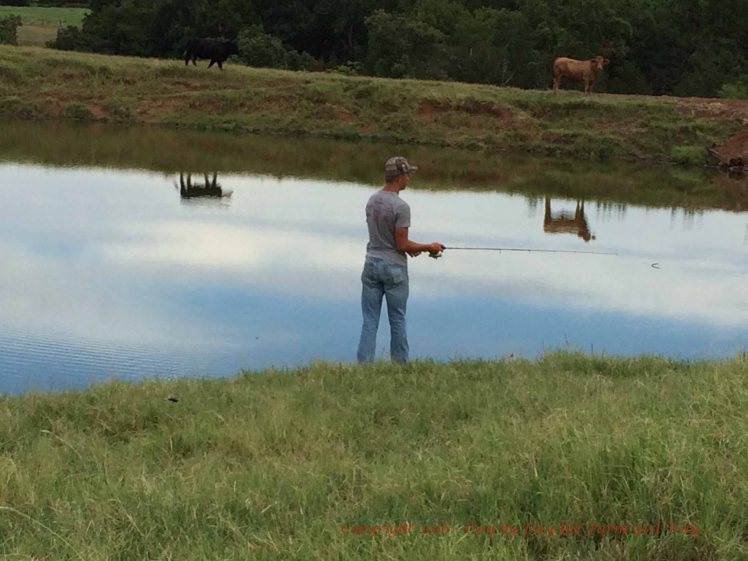
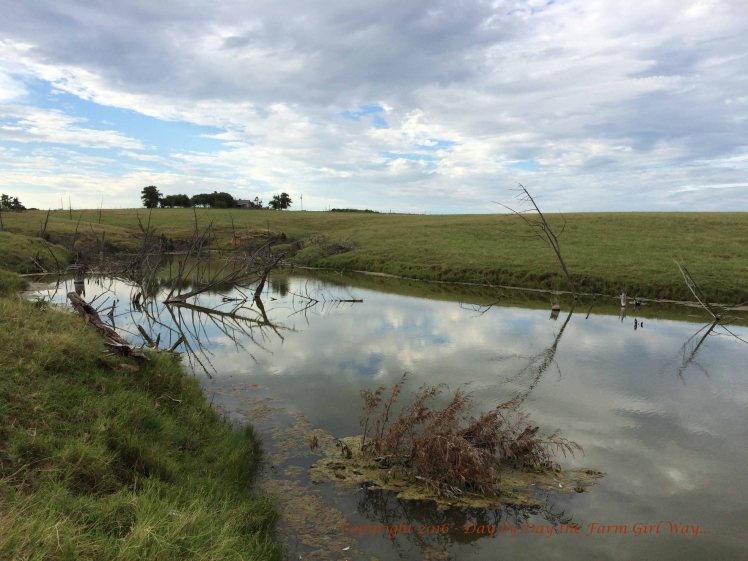

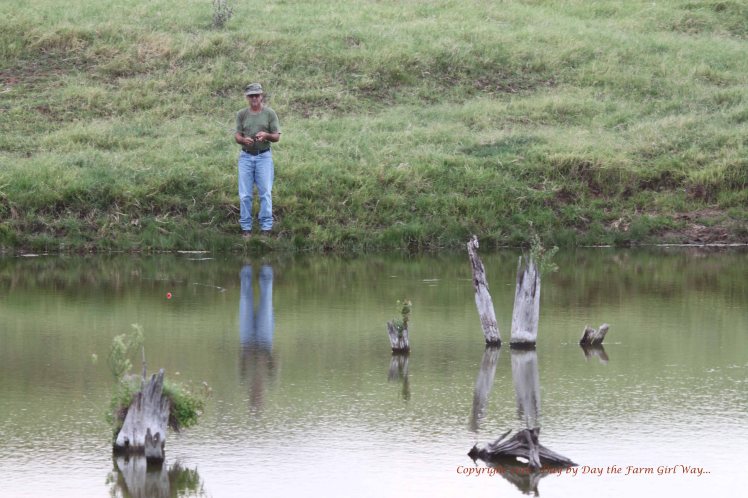
I fished with FD and Sid for a while, each of us finding a spot on the pond to concentrate on catching the big lunker. True to my nature, and not having much luck except to get my lure caught on just about every sunken structure in the water, I became bored after an hour. I finally gave up fishing altogether when I lost my favorite lure, and decided to try my luck with the camera instead. As a fisherman, I had looked for the best places to cast my lure, making sure to stay away from areas I might snag my line and have trouble. But, as a photographer, I was more interested in snagging sight of a frog or some interesting reflection on the water.

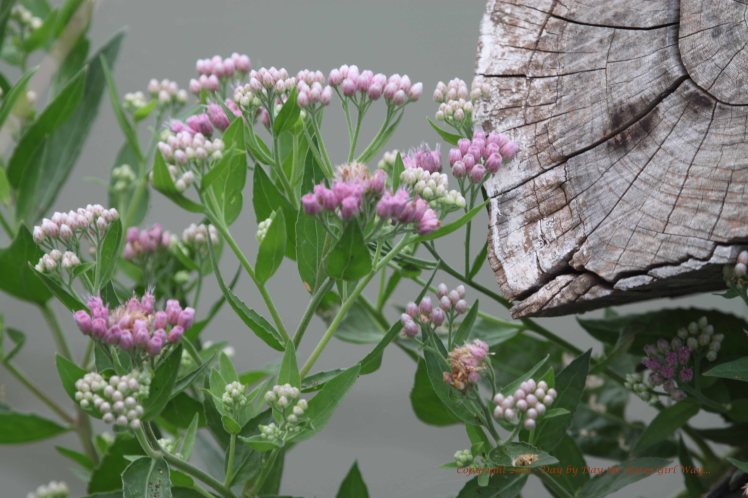

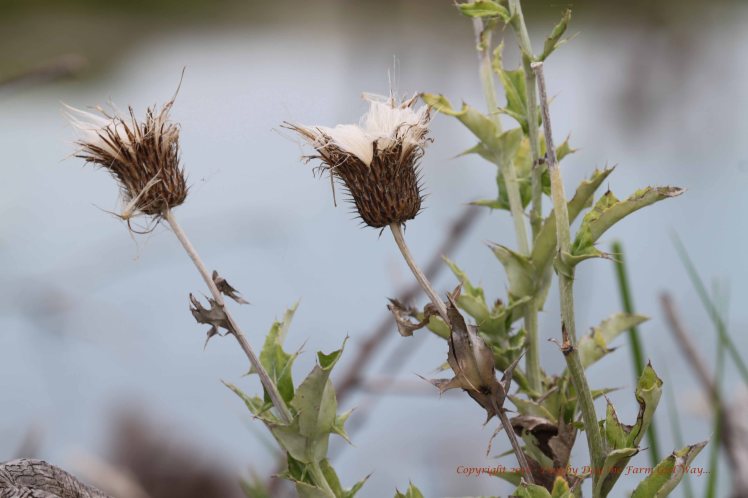


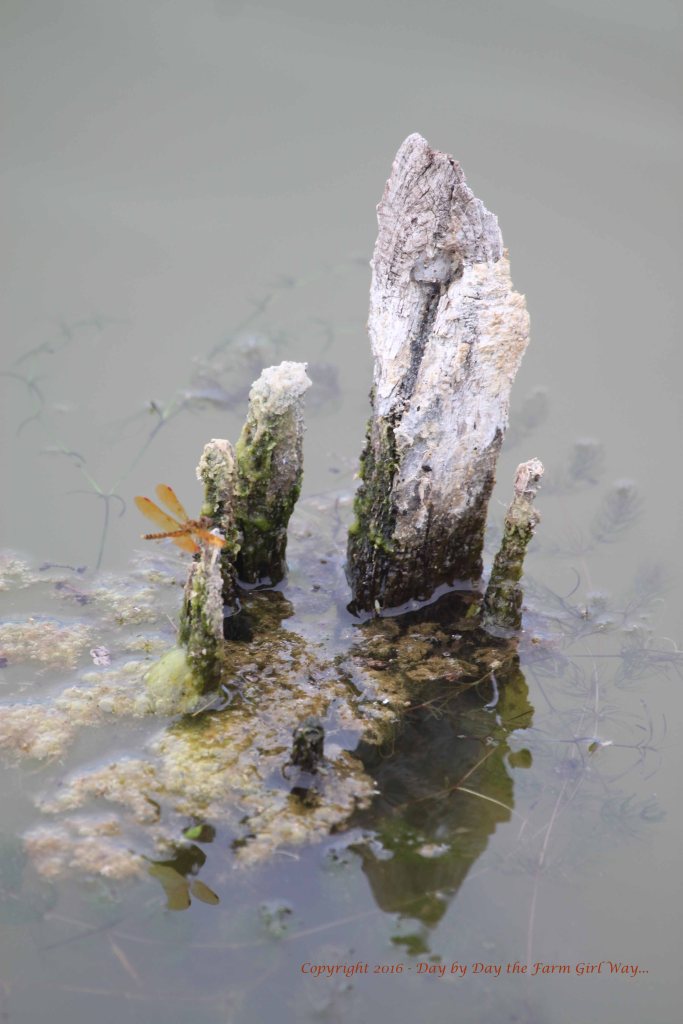
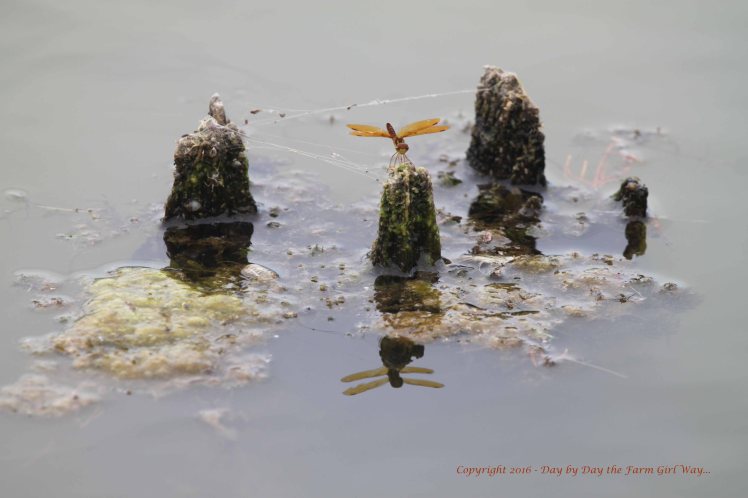
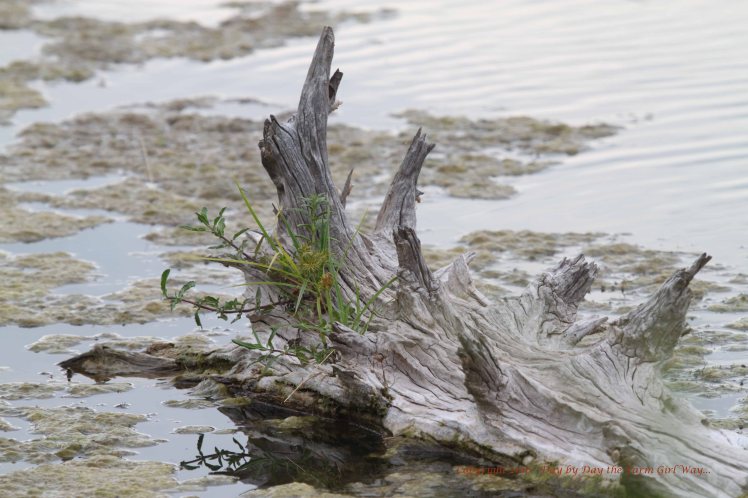
As the sun set that calm evening, I found plenty of beauty to photograph as I walked around the farm pond. And wouldn’t you know it, as we drove away from the pond down a path that took us to the main road, a large flock of cattle egrets rose up from the south and headed north. Somehow knowing they had successfully waited out the pesky photographer, the elusive cattle egrets winged purposefully back to their sanctuary of cedars in the farm pond…

© 2016 Day by Day the Farm Girl Way…
That first photo is award worthy!
LikeLike
Thank you, Kim. Unfortunately, they were the only two egrets left for a quick photograph. I will have to go out there again one evening and just wait for them to fly in and roost. However, getting the weather to cooperate might be a trick! Ha ha!
LikeLike
The half submerged stump which is the second to the last photos is my favorite and also the cattle egrets in flight. These are great pictures. I loved all of them but these two stand out for me. I don’t care to fish either. Standing in one spot is too boring when one can roam around and look at plants and interesting things to photograph.
Just for the record most county people in my area used to call the water reservoirs, tanks and I still do. But there are some folks that say pond. Some day I want to collect the country names and sayings that I learned growing up.
LikeLike
Thank you, Yvonne. I have never heard of the term “tank” for a pond. Some are called reservoirs here. I think a collection of names and sayings would be highly interesting and entertaining. When I moved to the South it was like a whole different language than what I grew up with in Nebraska!
LikeLiked by 1 person
Hmm now that is interesting that you call Oklahoma “south.” I still think of Okla. as north. You should write about the language in Nebraska and Oklahoma.
LikeLike
I supposed geographically we are “central” US, but most Okies consider themselves southerners!
LikeLiked by 1 person
Lori, thanks for the correction. From now on I’ll know that you are southern. 🙂
LikeLike
Ha ha!! I like being southern!
LikeLiked by 1 person
The egrets is a startling shot – that deserves to be printed – and what a lovely day you all had. c
LikeLike
Thank you! There have been some really great times with nieces and nephews this summer. I find the best times are spent in the quiet of nature.
LikeLike
I’m glad you put your pole down and picked up your camera! What gorgeous photos. The first one you caught of the egrets, although it’s the only one is amazing. I had to look at it for quite a while before I could figure out that the wings were down on the top bird. It looked as though it was wearing a cape or something billowy. I was looking at the reflections too and I love the one you caught of the dragonfly. I remember as a kid we also called the sewing needles and I truly believed that they would sew your skin if they landed on you so I was terrified of them. Now I love them and think they are simply beautiful. Truth be told I still hold a little fear of them…;-)
LikeLike
Hi Deb! I too noticed the beautiful downward arc of the wings on that egret… and the leg “liftoff” positions were interesting too. That’s what I love about photography – we see sort of superficially through the lens, but when we see the actual photograph there is so much more detail. I found it amusing that the dragonflies were likened to sewing needles as a child. Some of those ideas, stories and fears are difficult to let go of, aren’t they?
LikeLiked by 1 person
Yes I did notice the leg too. You are so right, you take the picture but the fun is in examining it after to see all that you captured. Yes those “old wives tales” or whatever they might be sure are hard to let go of..lol! 🙂
LikeLike
Yes, but the good thing is, once we’re cognizant, we don’t have to be fearful or believe that silly old stuff! 😀
LikeLiked by 1 person
True! 🙂
LikeLike
I’ve never been much of a fisher person. I’ve tried all kinds of fishing many times in my life, but catching good shots with my camera has always been more interesting to me. Some lovely shots you have, evocative of my childhood spent around a farm pond. Thank you Lori.
LikeLike
Yes, the camera has always held an interest for me. I can spend hours walking around seeing photographs wherever I go. It would have been adventurous growing up next to a pond. We were farm people but the nearest pond to us was a couple of miles down the road. We often frode our bicycles to the pond and spent hours at the roadside ditch gathering tadpoles and small frogs just for the fun of it.
LikeLiked by 1 person
We did that too, Lori!
LikeLike
Ha ha!! I’m not surprised anymore… we are so much alike! 😀
LikeLiked by 1 person
So frustrating, but that one shot of the egrets is beautiful. Do you think they would fly away if you parked further away and walked?
LikeLike
I have no idea. I think my best bet would be to wear camo and maybe head to the pond early and just wait it out. Generally, that’s how it is with most wildlife if you want the great shots!
LikeLike
Gorgeous shots, Lori. I love seeing the wildlife and plants of a “foreign” zone.
LikeLike
Thank you, Sandy. It was a fun evening poking around at water’s edge. That’s what I love about going someplace new… the “eye” for the photograph is a part of me. I am going to see the image regardless of where I am.
LikeLike
Nothing is as wonderful as farm ponds. So much life going on in and around those. (Cows standing with their relfection – somehow that’s a scene that says lazy summer days to me. Lovely memories)
That first picture is amazing!
LikeLike
Thank you. I thought the egret shot might be disappointing since they were flying away. Turns out it was a decent image – could have been sharper. Do you know it took me forEVER to find out the name of the Frog Fruit? I understand it is a common plant and very prolific in Texas. 🙂
LikeLiked by 1 person
Interesting post! Dragonflies and partially submerged wooden structures fascinate me too and I rarely leave a wetland without a few shots.
LikeLike
Thanks, Nick! Isn’t it amazing what posers dragonflies are? I can usually get very close to them before they finally take off. And there are so many different species!
LikeLike
Even though the egrets mostly evaded you, you managed to capture some stunning images of other subjects. That’s our gain for the absence of those egrets.
LikeLike
Thanks Audrey. I love when a photograph I expected to be poor, turns out to be a good one. It was a pleasant surprise!
LikeLike
Those stumps are wonderful! and make for such interesting photo subjects.
Pretty cool!
LikeLike
Thanks, Laurie! That pond was a pretty cool place!
LikeLike
Hi Lori, Sid’s visit certainly generated plenty of material for your posts – and provided a welcome break from your normal summer routine. It can be therapeutic to step outside regular concerns for a while. Congratulations on the acquisition of the pecan orchard – a sanctuary not only for wildlife but for you as well.
LikeLike
Thank you, Margaret. We are so excited about the pecan orchard. Already we enjoy relaxing evenings patrolling the area, talking about plans to clean up the property. Last week we had a state biologist out to look over the property and in a couple of weeks we will attend a Pecan 101 workshop. We’re never too old to learn!
Sid and his sister Emily have visited us a couple of times this year. They give us fresh perspective and we take time to get away from our usual stint here and get out a bit. I had not fished in years, but I had such fun! I hope we can get up to Nebraska this winter to visit them. That won’t be until Emma and Ronnie are out on their own, free to the wild. 🙂
LikeLike
What beautiful pics, Sister! I especially love the first one of egrets, stunning!! And of course I love the one of that handsome boy, Sid 🙂 . You really have a gift with the camera, you capture the beauty everywhere you go!!
LikeLike
My job as a photographer would have been much easier if Sid had cooperated. Just like his Dad, he looked away if he spied me lurking nearby aiming the camera at him! Ha ha! I still managed a few good photos that evening. Thank you for sharing your kids with us – they’ve been such a bright spot in our lives!! We just love those kids!!
LikeLike
It’s good to see you identifying the plants and animals in your photographs. I’m in Austin, so we share some of the same species. I had my own encounter with Ardea alba a few days after yours:
https://portraitsofwildflowers.wordpress.com/2016/09/05/contrasts/
They are indeed skittish birds and don’t let people get close.
Are you sure that’s ironweed in your seventh photograph? It looks like it could be marsh fleabane (Pluchea odorata):
http://www.wildflower.org/plants/result.php?id_plant=PLODO
LikeLike
Steve, you are so kind. Yes, I believe you are correct. I looked closely at the leaves and I believe it is marsh fleabane. Thank you for pointing that out… I’m always learning something new!
Austin is one of my favorite cities to visit. I’ll be sure to spend a little time checking out your blog! 🙂
LikeLike
As others have said that first picture is fantastic, Lori. I love the elegant and graceful wing action. They make me think of ballerinas. The reflections in the water are lovely and you were clever to capture the dragonflies. My brother loves to fish but I tend to take photographs while he throws out lines and waits patiently. 🙂
LikeLike
Jane, it’s funny you mention your brother and fishing. My brother loves to fish too. I called him “super caster” in a couple of old posts. He was great at casting… and getting snagged up in something under the water! ha ha! Sid surprised me with his patience, and he was so willing to help me when I needed it. I think Sid has found his niche in relaxing. Fishing is a good way to learn patience and just meditate in nature.
LikeLiked by 1 person
What great photos! Believe it or not, about 25 years ago, l took several pictures of a cicada killer wasp in the act of killing a cicada in my back yard here in Chicago. I was told by a curator at the Field Museum that the females do this so they can lay their eggs in the cicada, thus providing the baby wasps with lots of food before they hatch. Rich
LikeLike
Thank you, Richard! This is what I love about nature photography… so many times we learn from observing and photographing the oddities in nature. I mistakenly thought these were hornets – what most folks around here call them. It wasn’t until recently I discovered they were cidada killers. I have seen cicadas snatched up by Mississippi Kites a good bit on our place. They must be an important part of our ecosystem and much in demand!
LikeLiked by 1 person